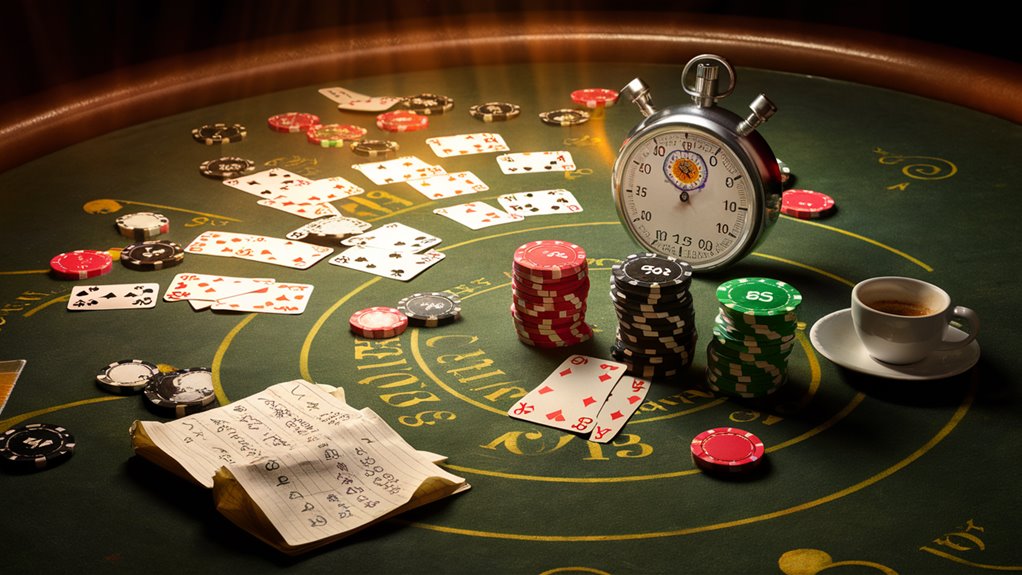The Truth About Card Counting in Blackjack: Common Myths Debunked
Understanding Card-Counting Basics
Card counting isn’t some mental feat so difficult that only superior humans can do it. Actually, this fundamental technical system is based on a simple three-point equation that uses +1, 0 and -1 as basic values. Counting becomes a matter of pure mathematics.
Dealing with the Process of Mastery
While Hollywood movies show very special types of mindboggling genius, reality is that anyone with normal abilities—given enough repetition and the proper methods—can become an excellent card counter over time.
Success Stories and Realities
In the case of people who count cards, the statistics show that fewer than 3% of all those who try actually become so adept at it as they could be called proficient. Of those who are counted in this way and actually make money for themselves from gambling or some related profession such as writing about it in magazines and newspapers, around half will then fail later on due to other forms of error. This all goes to prove that although someone might be good at projector card-counting, succeeding as a player in Blackjack itself presents an enormous challenge.
The Legal Position and Casino Reaction
Even though memory feats are in ones optional repertoire, a far greater premium in card counting is placed upon accurate mathematical tracking and keeping a cool head in narrow situations. Card counting is still completely legal; but casinos reserved the right not to do business with you if they so choose.
Basic Skills Needed
Without any special memory or mental acuity, successful card counting calls for:
- Commitment and Concentration
- Basic Mathematics
- Money Management with Discipline
- Composed thinking in tight positions
- Accuracy in keeping up running counts
These findings give evidence that good card counting is more a matter of diligence and systematic practice than favor for the brilliant.
The Memory Myth
Understanding Modern Systems of Card Counting
Contrary to popular belief, card counting does not require extraordinary memory feats.
The technique is based on a simple mathematical system with values assigned to cards at the same time that a running count is kept.
Most commonly used today is a method called the Hi-lo System, employing this straight-line point structure:
- Low cards (2 through 6, inclusive): 1 point
- High cards (10s and Aces): -1 value
Mechanics of Running Count
Running counts are based used point addition and subtraction mathematics as the cards turn up on the tables.
When the cards appear in a series -for example, a 5 followed by a King and an 8- the count will change accordingly.
The computation of the true count, reached by dividing running count figure with number of remaining decks, operates as the leading way to estimate a wager sizer decision.
Mathematics vs. Memory
The prime way of making money from card counting is through quick mental calculation, not memory.
When thousands of hands are examined, it is found that winning counter s keep tabs on just three factors:
- Keeping the running count
- Translating it to true form
- Guidance for basic strategy deviation
Research shows that good mental math skills and the ability to stay focused are far more helpful in the course of a card counting career where memory does not matter as much as people might imagine.
Legal Status and Rules of Casino
Going Legal Framework: Casino Card Counting & House Rules Guide
Structure of Legal Card Counting
Card counting is still technically legal in most parts of the world but casino s rigorously prosecute anyone who tries to do it.
Although it is not illegal to use memory, institutions Past to Present still have the right to expel suspected natural counter from their property
Varieties by Jurisdiction
There is a chapter in Nevada gaming law that specifically empowers casino s to send out proficient players and this hallmark has been followed up around the world.
However, Atlantic City is unique in protecting such players through court rulings- but casino s sidestep these through unfavorable rules and HK machining.
Banned Practices & Consequences
Devices-Based Counter
Devices for counting cards and electronic instruction are strictly banned. The use of a telephone, computer or even aids to count brings serious legally sanctioned punishment which can include:
- Criminal charges
- Property bans
- Civil law suit
Countermeasures by casinos
Modern casino s have all sorts of intricate methods to stop counters including;
- Facial recognition technology
- Cross-casino database sharing
- Highly trained surveillance personnel
- Pattern recognition systems
Casino Response Procedure
Because of the scale advantage establishments have, part of their response to suspected counting will be integrated with other actions: shuffle more often exclusive rules for specified tables Expelling the cards Multi-club ban To this end, casinos have designed methods that maximize security through new rules. By modifying table rules they are able to reduce the gambler’s chance of winning. The use of a continuous shuffle also greatly enhances the ability of their surveillance system to catch cheats. A recently established network unit table combines these two methods with computers that help to keep track on and through one another in real-time each aspect taking place.
The Mathematics behind card counting
A Fundamental Mathematical Principles Based on Three universal mathematical principles: probability tracking, true count conversion and betting correlation.
Understanding the Importance of These Concepts
For the strategy to be successful in card counting it is crucial these principles are grasped. Why Some Gamblers Always Win (and Others Lose)
Probability tracking
Probability tracking consists of knowing the critical ratio between high-value cards (10s and aces) and low-value cards (2-6) that remains in what is statistically a random selection but fundamentally affects winning probability. The ‘standard’ approach assigns specific values to the cards (+1 for low ones, -1 for high ones) and thus maintains a ‘running count’ throughout play.

True Count Conversion
The division of both the running count and the number of remaining decks, true count conversion is a critical mathematical adjustment that makes counting possible on an even level across multiple decks scenarios. For example, a running count of +8 in two decks remaining makes true count +4. The same running count with four decks left makes true count +2: two quite different strategies involved.
Betting Correlation
Betting correlation tells how accurately a counting system can predict profitable betting tendencies. With 97% hi-lo systems’ betting correlation is exceptionally good, indicating the system’s effectiveness at locating optimal betting situations dependent upon deck composition. This high correlation coefficient confirms its ability to predict effectively where and when one should gamble.
The Math behind card counting: Advanced metrics of counting
Running Count – Card value tracking in real time
True Count – Standardized count across multiple decks
Trading Efficiency for Security: The Relationship Between the Number of Hands Dealt and Profitable Opportunities
Deck Penetration: the Effect of Cards Dealt on Future Probability Increased
Ruth Prolongs the Life of Old Masters
Card Case Win Rate Analysis
How good is a card counter? The reality is that they encounter success only 2-3 percent of the time.
Comprehensive analysis of player outcomes shows that most would-be counters fall due to three key factors: human errors which cannot be corrected under stress, emotional decision-making and poor money management skills. How to Claim Free Spins & Maximize Profits
And Return on Investment
Data shows that among the proficient poker faces less than half can keep going for decades or longer after they have achieved master status.
While theoretical benefits may exceed 1.5% of the house edge, in reality it is just hard to get results because:
- Casino variable conditions
- Advanced countermeasures
- Difficulties in operation
Essential Success Factors
One-time Investment
To succeed as a card counter generally requires 100-200 hours of practice.
His bankroll needs to be large enough to cover regular fluctuations in capital of 100-200 times the average bet size.
Results
Players who are profitable over the long term share the following characteristics:
- accuracy in using basic strategy (99.5% or more)
- counting reliability (95%)
- stiff bankroll discipline
Therefore, given these rigorous criteria for success, it is unlikely that professional card counting in general can hope to do better than 2-3%.
None but the most determined and resourceful individuals can succeed in professional card counting.
How Long Does it Take to Train?
Card Counting Training Guide: What You Should Know!
The time needed to become proficient and constantly apply card counting is a solid 3 months.
Proficient card counters typically train 20-25 hours a week. By the time they reach master level, they have put in from 300 to 400 hours of practice work.
Three Key Training Phases
Stage 1: Developing a Basis for Basic Strategy
Mastery of basic strategy calls for 100-150 hours of concentrated practice. This recruits the essential framework necessary to successfully count cards. 먹튀검증 토토사이트
Phase 2: Developing Counting Skills
TheoryIn theory, after 100 – 150 hours of focused training, you can first understand and then perfect a card counting system.
MethodMost aspiring card counters start with the Hi-Lo counting method and it remains the standard entry point.
Phase 3:Application and Speed
If your performance needs to stand up to the pressures of a casino environment, then 100 – 150 hours of full-speed drills combined with practical application are certainly necessary. practice in this phase is designed to let a person maintain accurate counts under the most annoying of conditions.
Performance Requirements
When you want to play successfully as a skilled card counter, your requirements are as follows:
- 99%+ accuracy while timing each basic strategy command
- Precise counting, simultaneously with fighting off memory lapses and other distractions
- Automatic neural pathways for steady performance
- Constant practice without trying to rush the learning
Card counting at a professional level demands complete mastery through systematic training. The development of reliable counting abilities depends completely on dedicated practice throughout all three phases.










